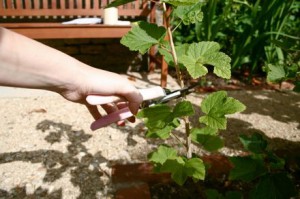First trimming
Pruning fruit and berry crops in the garden begins directly from landing. I take a plant, breaking the hole. A hole must be  such a depth so that the place of branching is approximately 5 cm under the ground. I choose the largest shoots (minimum three, a maximum of five). Escapes should not grow too low. Then I cut them down halfway: I make a cut directly above the eye, looking out. If the plant has a beautiful escape in the middle, then cut it somewhat higher than the rest.
such a depth so that the place of branching is approximately 5 cm under the ground. I choose the largest shoots (minimum three, a maximum of five). Escapes should not grow too low. Then I cut them down halfway: I make a cut directly above the eye, looking out. If the plant has a beautiful escape in the middle, then cut it somewhat higher than the rest.
Malinovaya Forms
When landing raspberries, I leave 40-60 cm to the length of escape, all branches cut off. The suspended branches cut in August. Raspberries are fruitful two-year shoots. Young go to growth in the year of planting, and bloom the next year in May. At the same time, the plant produces new young shoots, and in July next year they start fruit. After collecting the harvest, the process with a length of about 2 meters I immediately cut off almost at the very earth itself, and only the young shoots that seemed from the ground leaves, from young twigs only weak (leaving 8-10 shoots per meter). This is how raspberry trimming happens.
Yoshta, currant, gooseberry
Red currant and gooseberry are fruiting single and perennial shoots. Black - exclusively annual. The largest berries grow on the tops of annual shoots, which reach 15-30 cm. Bushes I cut off from late February to mid-March. In the first two years after landing, I never cut the currant. Starting from the third year, I spend regular thinning. If this is not done, old, non-giving fruits appear. Old shoots (they are black) I cut to give the plant the opportunity to release new ones. From young shoots, leave the strongest, but no more than five, to access the light inside the bush.
Yoshta and gooseberry also need to cut old shoots. I do everything just like on currant.
We cut a blackberry from the end of February to the end of March - the participants. Side cutting up to 2-4 sheets. If there are underdeveloped branches, I remove them after harvesting.













 Start a discussion ...
Start a discussion ...